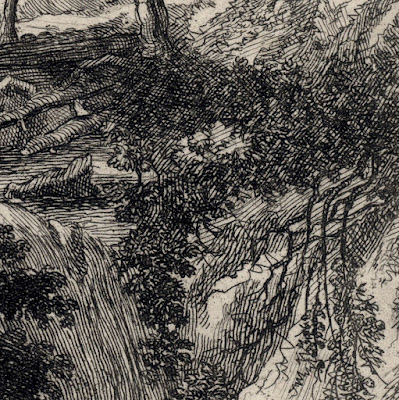Jan
Both (aka. Jan Dirksz Both) (1618/22–52)
"Wooden Bridge” (aka “The Wooden Bridge at Sulmona, near
Tivoli”), 1644–52, from the series of six plates, “Views of Rome and its
surroundings” (BM) or “Six Horizontal Landscapes” (TIB).
Etching on fine laid paper trimmed along the platemark and lined
with a support sheet.
Size: (sheet) 20.1 x 27.2 cm; (image borderline) 18.6 x 26.6 cm
State ii? (of vi) before the inscription “Both fe” below the image
borderline at left. (Compare with the state ii impression held by the National
Gallery of Art: https://www.nga.gov/collection/art-object-page.54389.html)
TIB 1978 7 (5). 10 (10) (Otto Naumann [ed.] 1978, “The Illustrated
Bartsch”, vol. 7, Abaris Books, New York, p. 16); Bartsch V.210.10; Hollstein
10
The British Museum offers the following description of this print:
“The wooden bridge Sulmona near Tivoli; crossed by peasants on
donkeys; a waterfall in background; from a series of six etchings of the
environs of Rome.”
See also the description of the print at the Rijksmuseum: http://hdl.handle.net/10934/RM0001.COLLECT.38169
The National Gallery of Ireland holds Jan Both’s original drawing for
this print: http://onlinecollection.nationalgallery.ie/objects/5313/bridge-in-a-mountain-landscape-with-waterfall;jsessionid=35B357F9C4C5CEBF42622A3397D4AFDE?ctx=c1cf7a92-39be-4640-8250-85d37b1a8bf7&idx=1
Condition: strong (lifetime) impression of museum quality (i.e.
there are no tears, holes, folds, abrasions, stains, or foxing and minimal signs
of use), trimmed at the platemark and laid upon an archival support sheet.
I am selling this exceptionally fine and very beautiful etching
for AU$323 (currently US$255.01/EUR206.51/GBP182.44 at the time of posting this
listing). Postage for this print is extra and will be the actual/true cost.
If you are interested in acquiring this marvellous and very rare print,
please contact me (oz_jim@printsandprinciples.com) and I will send you a PayPal
invoice to make the payment easy.
This print has been sold
Following in the footsteps of Claude, Poussin and Herman van
Swanevelt, Jan Both had explored and drawn the “hills outside of Rome” (National
Gallery of Ireland: Essential Guide, 2008). Certainly when I look at this
landscape, which I understand is “near Tivoli”, I can see strong relationships
in this composition to his fellow artists. For example, the scene is viewed
from an elevated viewpoint, the subject is bathed in light, the distance
suggests a zone of spiritual transcendence and the line work is kept to
notational strokes where no element is more important than the next.
What I find especially interesting about this etching is the way
that Both subtly changes his strokes to connote spatial depth. In his
treatment of the foreground area, for example, the strokes are a mixture of
dark toned lines that curl around foliage and change direction according to the
contours described. In the middle distance, the lines are lighter in tone
and tightly curled in tonal blocks to
portray broadly observed light patterns on trees. To suggest far distance, Both
uses even paler lines laid in regular patterns of hatched strokes that become increasingly horizontal in orientation in the furthest away aspects. Clifford
S Ackley (1981) in “Printmaking in the Age of Rembrandt” (exh. cat. Museum of
Fine Arts, Boston) makes the very insightful proposal in regard to Both’s use
of line that the artist was “searching for the black and white equivalent of
the golden haze of southern light that vaporises or makes the forms of the
landscape translucent …” (p. 176).








No comments:
Post a Comment
Please let me know your thoughts, advice about inaccuracies (including typos) and additional information that you would like to add to any post.